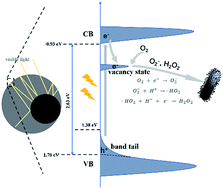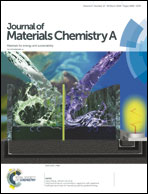Facile synthesis of oxygen defective yolk–shell BiO2−x for visible-light-driven photocatalytic inactivation of Escherichia coli†
Abstract
Oxygen defective yolk–shell BiO2−x spheres are successfully synthesized by a facile solvothermal method for the first time. The variations between the diffusion rate of the core and the formation rate of the shell, which are caused by the temperature gradient originating from the heating rate, result in the formation of BiO2−x spheres with different interior structures. The as-synthesized yolk–shell BiO2−x spheres possess distinctive oxygen vacancies, which are demonstrated by electron paramagnetic resonance and X-ray photoelectron spectral analyses. The oxygen vacancies with a high affinity for molecular oxygen, and the enhanced light absorption ability resulting from the multiple reflections of the incident light within the interior voids, play key roles in the photocatalytic bacterial inactivation. Scavenger studies indicate that O2− and H2O2 are the major reactive species guaranteeing the prominent oxidation ability toward the bacterial cells. This study would not only provide direct evidence for the oxygen vacancy promoted photocatalytic bacterial inactivation, but also shed light on the design of highly efficient photocatalysts with intricate yolk–shell structures.



 Please wait while we load your content...
Please wait while we load your content...